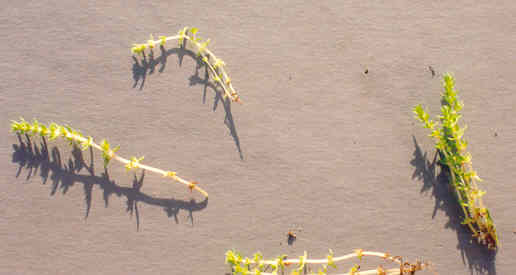
Crassula tillaea Lester-Garl.
 |
Crassula tillaea Lester-Garl.
Crassulaceae (Stonecrop Family)MediterraneanCrassula |
March Photo
Plant Characteristics:
Annual, stems generally erect, 1-6 cm. long, branched or not, in age red;
lf. 1-3 mm., oblong; tip +/-acute; infl.: fls. (1)-2 per lf. pair, crowded;
pedicel generally less than 0.5 mm.; fl. subsessile, +/- 1-1.5 mm.; sepals
generally 3, tip often outcurved, +/- 1-1.5 mm., lanceolate, tip acuminate;
petals 0.5-1 mm., narrowly lanceolate; fr.: follicles ascending, ovoid, tapered
to styles; seeds 1-2, elliptic.
Habitat:
Open, gravelly sites; less than 500 m.
North Coast Ranges, Sierra Nevada Foothills, Central Coast, Great Central
Valley, Southwestern California. (Hickman,
Ed. 525).
Name:
Latin, Crassula, diminutive of
thick. (Hickman, Ed. 524). New Latin, ea, in
the case of the of the early names made by Linnaeus and other early taxonomists
the ea ending was sometimes used in
forming generic names ending in vowels other than a. The other vowel was
first changed to a and then the ea
added. Ex: Jussiaea from Jussieu;
Tillaea from Tilli.
To avoid confusion these old names are retained.
(Jaeger 87
Tillaea,
named in recognition of Michael Angelo Tilli,
Italian Botanist. (Jepson 449).
General:
Rare in the study area, found only on the bluff top above and southerly
of San Joaquin Hills Rd. The habitat of this plant was probably destroyed by
grading for the homes constructed in 1997.
Not listed in Munz, Flora So. Calif.
or Abrams. (my comments).
About 300 species, especially from Africa.
Annual species are +/- worldwide. (Hickman,
Ed. 525).
Text Ref:
Hickman, Ed. 525.
Photo Ref:
March-April 95 #24.
Identity: by R. De Ruff,
confirmed by John Johnson.
First Found: May 1995.
Computer Ref: Plant Data 476.
Plant specimen donated to UC Riverside in 2004.
Last edit 8/4/05.